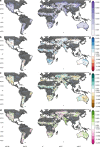Anthropogenic climate change has driven over 5 million km2 of drylands towards desertification
- PMID: 32737311
- PMCID: PMC7395722
- DOI: 10.1038/s41467-020-17710-7
Anthropogenic climate change has driven over 5 million km2 of drylands towards desertification
Abstract
Drylands cover 41% of the earth's land surface and include 45% of the world's agricultural land. These regions are among the most vulnerable ecosystems to anthropogenic climate and land use change and are under threat of desertification. Understanding the roles of anthropogenic climate change, which includes the CO2 fertilization effect, and land use in driving desertification is essential for effective policy responses but remains poorly quantified with methodological differences resulting in large variations in attribution. Here, we perform the first observation-based attribution study of desertification that accounts for climate change, climate variability, CO2 fertilization as well as both the gradual and rapid ecosystem changes caused by land use. We found that, between 1982 and 2015, 6% of the world's drylands underwent desertification driven by unsustainable land use practices compounded by anthropogenic climate change. Despite an average global greening, anthropogenic climate change has degraded 12.6% (5.43 million km2) of drylands, contributing to desertification and affecting 213 million people, 93% of who live in developing economies.
Conflict of interest statement
The authors declare no competing interests.
Figures




References
-
- Bai, Z. G., Dent, D. L., Olsson, L. & Schaepman, M. E. Global Assessment of Land Degradation and Improvement. 1. Identification by Remote Sensing (ISRIC, Wageningen, 2008).
-
- Dudley, N. & Alexander, S. Global Land Outlook (UNCCD, 2017).
-
- Scholes, R. et al. Summary for Policymakers of the Thematic Assessment Report on Land Degradation and Restoration of the Intergovernmental Science-Policy Platform on Biodiversity and Ecosystem Services. https://www.ipbes.net/sites/default/files/downloads/ipbes-6-15-add-5_spm... (IPBES, Bonn, 2018).
-
- Reynolds JF, et al. Global desertification: building a science for dryland development. Science. 2007;316:847–851. - PubMed
-
- Gibbs HK, Salmon JM. Mapping the world’s degraded lands. Appl. Geogr. 2015;57:12–21.
Publication types
LinkOut - more resources
Full Text Sources

